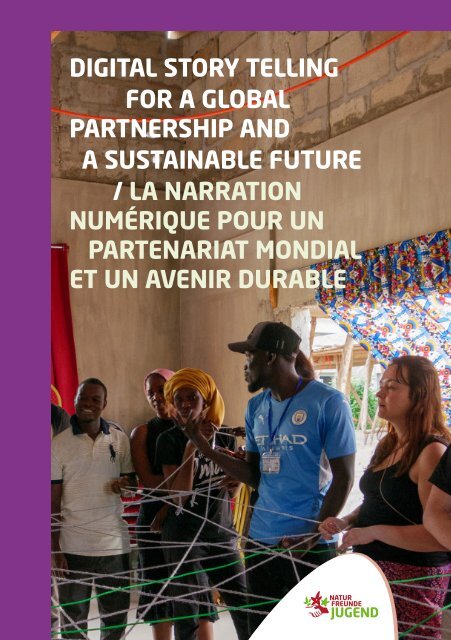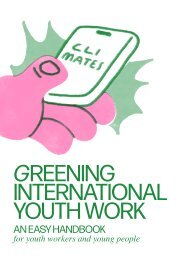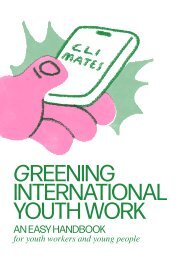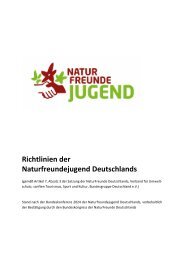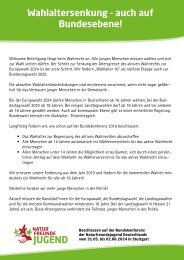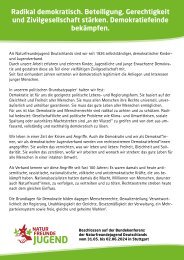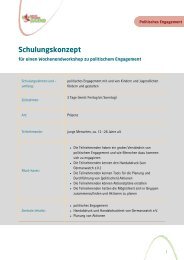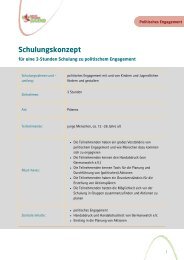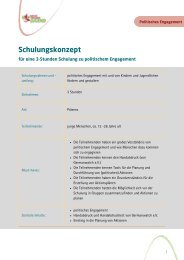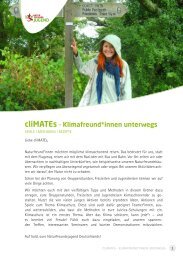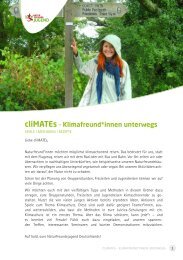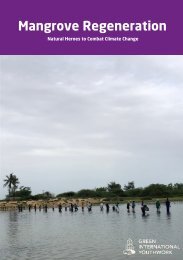Digital story telling for a global Partnership and a sustainable future
This handbook summarizes the experiences of young naturefriends from Senegal, Benin and Germany gathered in a joint project over the course of one and a half years. This handbook presents results that have emerged from the practice of working together, discussing and getting to know each other.
This handbook summarizes the experiences of young naturefriends from Senegal, Benin and Germany gathered in a joint project over the course of one and a half years. This handbook presents results that have emerged from the practice of working together, discussing and getting to know
each other.
Create successful ePaper yourself
Turn your PDF publications into a flip-book with our unique Google optimized e-Paper software.
DIGITAL STORY TELLING<br />
FOR A GLOBAL<br />
PARTNERSHIP AND<br />
A SUSTAINABLE FUTURE<br />
/ LA NARRATION<br />
NUMÉRIQUE POUR UN<br />
PARTENARIAT MONDIAL<br />
ET UN AVENIR DURABLE
DIGITAL STORY TELLING FOR A GLOBAL<br />
PARTNERSHIP AND A SUSTAINABLE<br />
FUTURE LA NARRATION NUMÉRIQUE POUR<br />
UN PARTENARIAT MONDIAL ET UN<br />
AVENIR DURABLE<br />
Preface<br />
How is it possible <strong>for</strong> naturefriends from<br />
different parts of the world to work together<br />
in solidarity? How can we live common<br />
values, st<strong>and</strong> together in our struggles <strong>and</strong><br />
jointly contribute to achieving our (political)<br />
goals without negating differences between<br />
the organizations, the people involved, the<br />
political contexts?<br />
This h<strong>and</strong>book summarizes the experiences<br />
of young naturefriends from Senegal, Benin<br />
<strong>and</strong> Germany gathered in a joint project<br />
over the course of one <strong>and</strong> a half years.<br />
This h<strong>and</strong>book presents results that have<br />
emerged from the practice of working<br />
together, discussing <strong>and</strong> getting to know<br />
each other. It is aimed in particular at<br />
(<strong>future</strong>) group leaders of international<br />
encounters (of naturefriends) that take place<br />
in a South-(South-)North context.<br />
The first part is talking more generally<br />
about our cooperation reflecting on our<br />
underst<strong>and</strong>ing of diversity, the actuality of<br />
coloniality, the importance of the SDGs <strong>and</strong><br />
Préface<br />
Comment est-il possible pour les ami.e.s de<br />
la nature de différentes parties du monde<br />
de travailler ensemble dans la solidarité<br />
? Comment pouvons-nous faire vivre des<br />
valeurs communes, mener des luttes et<br />
contribuer conjointement à la réalisation<br />
de nos objectifs (politiques) sans nier<br />
les différences entre les organisations,<br />
les personnes impliquées, les contextes<br />
politiques ?<br />
Ce manuel résume les expériences de jeunes<br />
ami·e·s de la nature du Sénégal, du Bénin et<br />
d‘Allemagne, rassemblé·e·s dans un projet<br />
commun pendant un an et demi. Le manuel<br />
présente les résultats qui ont émergé de<br />
la coopération, de la discussion et du fait<br />
d´apprendre à se connaître. Il s‘adresse en<br />
particulier aux (futur·e·s) encadrant·e·s de<br />
rencontres internationales (d‘ami·e·s de la<br />
nature) se déroulant dans un contexte Sud-<br />
Sud-Nord.<br />
Alors que la première partie revient plus généralement<br />
sur différents aspects de la coopéra-<br />
LA NARRATION NUMÉRIQUE 3
our different educational approaches. The<br />
second part of this h<strong>and</strong>book focuses on<br />
the method of digital <strong>story</strong><strong>telling</strong>, which<br />
has proven to be a productive method in the<br />
context of diversity-conscious, online <strong>and</strong><br />
face-to-face cooperation. Each paragraph<br />
is accompanied by a graphic record that<br />
represents the concluding discussion<br />
between a group of youth leaders <strong>and</strong><br />
coordinators that participated in the project.<br />
tion, la deuxième partie se concentre sur<br />
la méthode du récit numérique, qui s‘est<br />
avérée être une méthode productive dans le<br />
contexte d‘une coopération consciente de<br />
la diversité, en ligne comme en présentiel.<br />
Chaque paragraphe est accompagné d‘un<br />
enregistrement graphique qui illustre la<br />
discussion finale entre un groupe de jeunes<br />
leaders et de coordinateurs ayant participé<br />
au projet.<br />
Awareness of differences <strong>and</strong> our underst<strong>and</strong>ings of<br />
diversity / La sensibilisation aux différences et notre<br />
compréhension de la diversité<br />
We are all equal yet still each is diverse <strong>and</strong><br />
unique. In our cooperation <strong>and</strong> especially<br />
during our encounters, we experience this<br />
diversity of differences in our everyday togetherness.<br />
We become aware that some<br />
things we experience as “quite normal”<br />
could also be quite different. We want to<br />
learn together how to deal with such differ-<br />
Nous sommes tous égaux mais chacun·e<br />
est différent et unique. Dans notre coopération<br />
et surtout lors de nos rencontres,<br />
nous faisons l‘expérience de cette diversité<br />
de différences au quotidien. Nous prenons<br />
conscience que certaines choses que nous<br />
considérons comme «tout à fait normales»<br />
peuvent aussi être tout à fait différentes.<br />
4 DIGITAL STORY TELLING
ences. This also means to feel <strong>and</strong> endure our<br />
own insecurities, to look at the mechanisms<br />
behind misunderst<strong>and</strong>ings <strong>and</strong> to be able to<br />
talk about different ideas <strong>and</strong> underst<strong>and</strong>ings.<br />
We don‘t want to consolidate these<br />
differences, <strong>and</strong> thus, <strong>for</strong> example, inscribe<br />
fixed differences between naturefriends in<br />
Senegal, Germany <strong>and</strong> Benin, but rather<br />
look more closely at how we are different,<br />
even within a national group. At the same<br />
time, we do not want to erase differences in<br />
our cooperation. We want to move <strong>for</strong>ward<br />
together in diversity. So we rather want to<br />
represent a salad bowl, than a melting pot.<br />
We know that differentiation, i.e. the creation<br />
<strong>and</strong> differentiation of supposedly distinct<br />
groups, often <strong>and</strong> easily goes h<strong>and</strong> in<br />
h<strong>and</strong> with an valuation, mostly in connection<br />
with social discourses <strong>and</strong> power relations,<br />
<strong>and</strong> is thus closely linked to exclusion<br />
<strong>and</strong> discrimination or privileges.<br />
Together we will look at how inequalities<br />
<strong>and</strong> injustices work, how we all are involved<br />
<strong>and</strong> what we can do against them. Together<br />
we st<strong>and</strong> up against discrimination <strong>and</strong> fight<br />
<strong>global</strong>, racist, neo-colonial inequalities.<br />
Nous voulons apprendre ensemble à gérer ces<br />
différences. Cela signifie également ressentir<br />
et être capable de supporter nos éventuelles<br />
propres insécurités, d‘aller au fond des mécanismes<br />
qui les sous-tendent, de parler d‘idées<br />
et de compréhensions différentes.<br />
Nous ne voulons pas consolider ces<br />
différences, et donc, par exemple, fixer les<br />
différences entre les Ami·e·s de la Nature<br />
au Sénégal, en Allemagne et au Bénin,<br />
mais plutôt regarder de plus près en quoi<br />
nous sommes différents, même au sein<br />
d‘un groupe national. En parallèle, nous ne<br />
voulons pas effacer les différences dans notre<br />
coopération. Nous voulons avancer ensemble<br />
dans la diversité. Nous voulons donc plutôt<br />
représenter un saladier qu‘un melting-pot.<br />
Nous savons que la différenciation, c‘està-dire<br />
la création et la différenciation de<br />
groupes prétendument distincts, va souvent<br />
et facilement de pair avec une valorisation, le<br />
plus souvent en relation avec des discours sociaux<br />
et des relations de pouvoir, et est donc<br />
étroitement liée à l‘exclusion et à la discrimination<br />
ou aux privilèges.<br />
Ensemble, nous examinerons comment fonctionnent<br />
les inégalités et les injustices, en<br />
quoi elles nous concernent toutes et tous,<br />
et comment nous pouvons agir contre elles.<br />
Ensemble, nous nous dressons contre les<br />
discriminations et combattons les inégalités<br />
<strong>global</strong>es, racistes et néo-coloniales.<br />
LA NARRATION NUMÉRIQUE<br />
5
The Meaning of (post)colonialism <strong>and</strong> the Actuality of coloniality<br />
in South-North Encounters / La notion de (post)<br />
colonialisme et l‘actualité de la colonialité dans les rencontres<br />
Sud-Nord.<br />
6 DIGITAL STORY TELLING
When we engage as naturefriends from<br />
Benin, Germany <strong>and</strong> Senegal on questions of<br />
education, the environment <strong>and</strong> solidarity,<br />
we also have to take a look at historical<br />
<strong>and</strong> current power relationships between<br />
our regions. All the countries we live in<br />
are heavily influenced by the hi<strong>story</strong> of<br />
colonialism <strong>and</strong> the current system of<br />
coloniality, in which we are positioned in<br />
differently.<br />
We engaged in a conversation about the<br />
daily experiences with <strong>and</strong> the presence of<br />
the topic of colonialism. In this discussion<br />
the different experiences of participants in<br />
Benin, Germany <strong>and</strong> Senegal became visible.<br />
For instance, participants from Germany<br />
shared that the hi<strong>story</strong> of colonialism or the<br />
presence of coloniality was not big of a topic<br />
in their upbringing or educational system<br />
even though Germany has a big part in the<br />
hi<strong>story</strong> of colonialism <strong>and</strong> the presence of<br />
coloniality.<br />
We continued to look closer at the two<br />
concepts of colonisation <strong>and</strong> coloniality.<br />
If we consider that colonisation can be<br />
circumscribed in space <strong>and</strong> time, we can say<br />
that coloniality goes beyond colonialism.<br />
Historically, colonisation was an enterprise<br />
of capture, exploitation <strong>and</strong> accumulation<br />
Lorsque nous nous engageons, en<br />
tant qu‘ami·e·s de la nature du Bénin,<br />
de l‘Allemagne et du Sénégal, sur des<br />
questions d‘éducation, d‘environnement<br />
et de solidarité, nous devons également<br />
examiner les relations de pouvoir historiques<br />
et actuelles entre nos régions. Tous les pays<br />
dans lesquels nous vivons sont <strong>for</strong>tement<br />
influencés par l‘histoire du colonialisme et<br />
actuellement le système de la colonialité<br />
et nous sommes positionnés différemment<br />
dans cette situation.<br />
Nous nous sommes engagés dans une<br />
conversation autour des expériences quotidiennes<br />
sur ce thème et de la présence<br />
même du sujet du colonialisme. Dans cette<br />
discussion, les différentes expériences des<br />
participant·e·s du Bénin, de l‘Allemagne et<br />
du Sénégal sont apparues. Les participant·e·s<br />
allem<strong>and</strong>·e·s ont par exemple indiqué que<br />
l‘histoire du colonialisme ou la présence de<br />
la colonialité n‘était pas un sujet important<br />
au cours de leur éducation ou dans leur système<br />
éducatif, même si l‘Allemagne joue un<br />
rôle important dans l‘histoire du colonialisme<br />
et la présence de la colonialité.<br />
Nous avons continué à examiner de plus<br />
près les conséquences du colonialisme et<br />
de la colonialité. Si nous considérons que<br />
la colonisation peut être circonscrite dans<br />
l‘espace et le temps, nous pouvons dire que<br />
la colonialité va au-delà du colonialisme.<br />
Historiquement, la colonisation a été une<br />
entreprise de capture, d‘exploitation et<br />
d‘accumulation de richesses à partir du XVI e<br />
siècle, qui s‘est terminée par la décolonisation,<br />
qui reste un processus inachevé. En revanche,<br />
la colonialité, ce système de domination<br />
politique, économique, juridique, culturel<br />
et environnemental, né du colonialisme<br />
moderne, a survécu à la colonisation et<br />
contrôle largement les relations actuelles<br />
Nord/Sud. Aujourd‘hui plus que jamais,<br />
la colonialité est intimement liée aux<br />
LA NARRATION NUMÉRIQUE<br />
7
of wealth from the 16th century onwards,<br />
which ended with decolonisation, which<br />
remains an unfinished process. On the other<br />
h<strong>and</strong>, coloniality, this system of political,<br />
economic, legal, cultural <strong>and</strong> environmental<br />
domination, born of modern colonialism, has<br />
survived colonisation <strong>and</strong> largely controls<br />
current North/South relations. Today more<br />
than ever, coloniality is intimately linked<br />
to the ecological <strong>and</strong> health crises in that<br />
it constitutes a system that disregards<br />
the human element <strong>and</strong> the environment<br />
of the peoples under domination. The<br />
Anthropocene can even trace its roots, not<br />
to the beginning of the industrial era, but<br />
to the period that marked the beginning of<br />
the European conquest of the world in 1492,<br />
which is also considered to be the starting<br />
point <strong>for</strong> the upheaval of the agricultural,<br />
botanical <strong>and</strong> zoological map of the globe.<br />
crises écologiques et sanitaires dans la<br />
mesure où elle constitue un système qui<br />
ne tient pas compte de l‘élément humain<br />
et de l‘environnement des peuples sous<br />
domination. L‘Anthropocène trouve même<br />
ses racines, non pas au début de l‘ère<br />
industrielle, mais à la période qui a marqué le<br />
début de la conquête européenne du monde<br />
en 1492, considérée également comme le<br />
point de départ du bouleversement de la<br />
carte agricole, botanique et zoologique du<br />
globe.<br />
The hi<strong>story</strong> of the naturefriends movement in Europe<br />
<strong>and</strong> Africa <strong>and</strong> the intertwined destiny of humanity <strong>and</strong><br />
nature / L‘histoire du mouvement des amis de la nature<br />
en Europe et en Afrique et l‘avenir étroitement lié de<br />
l‘humanité et de la nature.<br />
In the 19th century, Austrian workers<br />
worked like convicts in the coal mines under<br />
extremely degrading conditions. And every<br />
evening, in order to drown their suffering,<br />
they took refuge in the pubs <strong>and</strong> thus ended<br />
up seriously mortgaging their health. Aware<br />
of the sanitary degradation that they were<br />
incurring, a group of men decided, in 1895,<br />
to break this vicious circle of mine <strong>and</strong> pubs,<br />
by launching the naturefriends movement,<br />
whose main objective was to save man<br />
by making him profit from the benefits of<br />
nature, which was until this moment a<br />
privilege of the aristocrats. The greeting<br />
“Berg Frei” that soon became a symbol of<br />
Au XIX e siècle, les ouvriers autrichiens travaillaient<br />
comme des <strong>for</strong>çats dans les mines<br />
de charbon, dans des conditions extrêmement<br />
dégradantes. Et chaque soir, pour<br />
noyer leurs souffrances, ils se réfugiaient<br />
dans les pubs et finissaient ainsi par hypothéquer<br />
gravement leur santé. Conscients de<br />
la dégradation sanitaire qu‘ils subissaient,<br />
un groupe d‘hommes décida, en 1895, de<br />
briser ce cercle vicieux de la mine et des débits<br />
de boissons, en lançant le mouvement<br />
des Ami·e·s de la Nature, dont l‘objectif principal<br />
était de sauver l‘Homme en lui faisant<br />
profiter des bienfaits de la nature, qui était<br />
jusqu‘alors un privilège des aristocrates. Le<br />
8 DIGITAL STORY TELLING
ecognition of the organization represents<br />
this original dem<strong>and</strong>: free access to nature<br />
in the mountains.<br />
The 1970s in the countries south of the<br />
Sahel were marked by recurrent droughts,<br />
causing a strong degradation of ecosystems<br />
<strong>and</strong> challenging the fauna as well as the<br />
flora. It is in this context where humans,<br />
as an essential element of biodiversity,<br />
were threatened in their existence, that the<br />
Senegale se organisation of naturefriends<br />
was born to come to the rescue of nature<br />
<strong>and</strong> at the same time save man. It spreaded<br />
rapidly in various african countries.<br />
While at the origin of the naturefriends<br />
movement in Europe we recognize the objective<br />
to save man by going into nature, the<br />
origin of naturefriends on the African continent<br />
goes to the rescue of nature to preserve<br />
man. The two histories show that the <strong>future</strong><br />
of humanity <strong>and</strong> nature is so intertwined<br />
that the salvation of one through the other<br />
is as inseparable as they are ecological <strong>and</strong><br />
social topics.<br />
salut «Berg Frei» qui devient rapidement un<br />
symbole de reconnaissance de l‘organisation<br />
représente cette revendication originelle :<br />
l‘accès libre à la nature en montagne.<br />
Les années 70 dans les pays du sud du Sahel<br />
ont été marquées par des sécheresses récurrentes,<br />
provoquant une <strong>for</strong>te dégradation<br />
des écosystèmes et mettant à mal la faune<br />
comme la flore. C‘est dans ce contexte où<br />
l‘Homme, en tant qu‘élément essentiel de la<br />
biodiversité, était menacé dans son existence,<br />
que l‘Association sénégalaise des Amis de la<br />
Nature qui se rép<strong>and</strong> rapidement dans différents<br />
pays africains est née pour venir au<br />
secours de la nature et par la même occasion<br />
sauver l‘Homme.<br />
Alors qu‘à l‘origine du mouvement des<br />
ami·e·s de la nature en Europe on reconnaît<br />
l‘objectif de sauver l‘Homme en allant dans<br />
la nature, l‘origine des ami·e·s de la nature<br />
sur le continent africain va au secours de<br />
la nature pour préserver l‘Homme. Ces deux<br />
histoires montrent que l‘avenir de l‘humanité<br />
et de la nature est tellement lié que le salut<br />
de l‘une par l‘autre est indissociable puisqu‘il<br />
s‘agit de sujets écologiques et sociaux.<br />
LA NARRATION NUMÉRIQUE<br />
9
SDGs <strong>and</strong> the notion of partnership<br />
SDGs & SDG17 / Les ODD et la notion de partenariat<br />
In discussing the concept of the SDGs, we<br />
identified several strengths of the concept<br />
as well as criticisms. The SDGs represent<br />
an important further development of the<br />
Millennium Development Goals, which now<br />
apply equally to all countries <strong>and</strong> thus make<br />
clear that ef<strong>for</strong>ts are needed everywhere<br />
in the world to achieve <strong>sustainable</strong><br />
development.<br />
In our discussion, the background of the<br />
SDGs was critically examined <strong>and</strong> it was<br />
questioned how much influence the African<br />
countries have had in the process of <strong>for</strong>mulating<br />
them <strong>and</strong> to what extent colonial conditions<br />
continue to be reproduced in international<br />
organizations. It was also criticized<br />
that the SDGs become empty words if they<br />
En discutant du concept des ODD, nous avons<br />
constaté que celui-ci présentait plusieurs<br />
points <strong>for</strong>ts, mais aussi des points à critiquer.<br />
Les ODD représentent un approfondissement<br />
important des objectifs du Millénaire pour le<br />
développement, qui s‘appliquent désormais<br />
à tous les pays et montrent clairement que<br />
des ef<strong>for</strong>ts sont nécessaires partout dans le<br />
monde pour parvenir à un développement durable.<br />
Au cours de la discussion, le contexte<br />
des ODD a fait l‘objet d‘un examen critique<br />
et l‘on s‘est interrogé sur l‘influence des pays<br />
africains dans le processus de leur <strong>for</strong>mulation<br />
et la façon dont les conditions coloniales<br />
continuent d‘être reproduites dans les<br />
organisations internationales. Nous avons<br />
également critiqué le fait que les ODD deviennent<br />
des mots vides de sens si l‘on ne<br />
10<br />
DIGITAL STORY TELLING
only become tools <strong>for</strong> getting funding. We<br />
came to the conclusion that the SDGs are<br />
less important as written rules or abstract<br />
concepts, but to what extent they enable<br />
real activities. Because after all, that is what<br />
we as naturefriends are all about!<br />
We regard the SDG 17 “Strengthen the<br />
means of implementation <strong>and</strong> revitalize<br />
the <strong>global</strong> partnership <strong>for</strong> <strong>sustainable</strong><br />
development” as the foundation on which<br />
all other SDGs are built. All the other goals<br />
cannot work without Goal 17, because today<br />
no part of the world can live in autarky.<br />
Whether we are from the Global North or<br />
the Global South, we need each other, we<br />
need the experiences of everyone.<br />
Implementing <strong>and</strong> strengthening partner-ships,<br />
also between multiple organizations from the<br />
Global South, is vital to achieve the goals<br />
that were set in the 2030 Agenda. With our<br />
common activities we want to show that<br />
SDG17 is not the last wheel on the wagon,<br />
but an important vehicle to implement all<br />
the other SDGs. We all need this SDG17 to<br />
ensure that our 2030 Agenda is one that is<br />
implemented with maximum success <strong>for</strong> the<br />
benefit of all inhabitants of the planet.<br />
finance plus de projets qui ne sont pas liés aux<br />
ODD. Nous sommes arrivés à la conclusion que<br />
les ODD sont en réalité moins importants en<br />
tant que règles écrites ou concepts abstraits<br />
que dans la mesure où ils rendent possibles<br />
des actions concrètes. Après tout, c‘est notre<br />
raison d‘être en tant qu’Ami·e·s de la Nature !<br />
Nous considérons l‘ODD 17 «Ren<strong>for</strong>cer les<br />
moyens de mise en œuvre et revitaliser le<br />
partenariat mondial pour le développement<br />
durable» comme le fondement sur lequel tous<br />
les autres ODD sont construits. Tous les autres<br />
objectifs ne peuvent fonctionner sans l‘objectif<br />
17, car aujourd‘hui, aucune partie du<br />
monde ne peut vivre en autarcie. Que nous<br />
soyons du Nord ou du Sud, nous avons besoin<br />
les uns des autres,<br />
nous avons besoin des<br />
expériences de chacun.<br />
La mise en œuvre et le<br />
ren<strong>for</strong>cement des partenariats,<br />
également entre<br />
plusieurs organisations<br />
du Sud, sont essentiels<br />
pour atteindre les objectifs<br />
fixés dans l‘Agenda<br />
2030. Avec nos activités<br />
communes, nous voulons<br />
montrer que l‘ODD 17<br />
n‘est pas la cinquième<br />
roue du carrosse, mais un<br />
vecteur important pour la mise en œuvre de<br />
tous les autres ODD. Nous avons tous besoin<br />
de cet ODD 17 pour garantir que l‘Agenda<br />
2030 soit mis en œuvre avec un maximum de<br />
succès pour le bénéfice de tous les habitants<br />
de la planète.<br />
LA NARRATION NUMÉRIQUE 11
Consequences <strong>for</strong> our pedagogical work: Educational<br />
projects <strong>and</strong> approaches / Les conséquences pour notre<br />
travail éducatif : Projets et approches pédagogiques<br />
12<br />
Within this partnership, three organisations<br />
with different educational approaches<br />
<strong>and</strong> projects worked together. Despite<br />
the differences, these can nevertheless<br />
overlap or complement each other. It was<br />
there<strong>for</strong>e important to discuss in advance<br />
the similarities <strong>and</strong> specificities of our<br />
pedagogical approaches <strong>and</strong> to reflect<br />
together on how we could implement them<br />
during the youth exchange in Zinvié (Benin).<br />
The following is a summary of the points to<br />
keep in mind <strong>for</strong> an exchange of this type.<br />
Any pedagogical approach must first take<br />
into account <strong>and</strong> respect the following<br />
essential elements:<br />
» Cultural, political <strong>and</strong> religious<br />
background<br />
» Target group (homogeneous or<br />
heterogeneous)<br />
» Diversity of perspectives<br />
DIGITAL STORY TELLING<br />
Au sein de ce partenariat ont travaillé<br />
ensemble trois organisations avec des<br />
approches et projets pédagogiques différents.<br />
Malgré les différences, ceux-ci peuvent<br />
néanmoins se recouper ou se compléter. Il<br />
était donc important de discuter en amont<br />
les points communs ainsi que les spécificités<br />
de nos approches pédagogiques et de<br />
réfléchir ensemble à la manière dont nous<br />
allions pouvoir les mettre en place lors de<br />
la rencontre de jeunes à Zinvié (Bénin). Cidessous<br />
sont résumés les points à garder en<br />
tête pour un échange de ce type.<br />
Toute approche pédagogique doit d’abord<br />
tenir compte des éléments indispensables<br />
suivants et les respecter :<br />
» Contexte culturel, cultuel politique, et<br />
religieux<br />
» Groupe cible (homogène ou<br />
hétérogène)<br />
» Diversité des perspectives
In the context of a heterogeneous group, it is<br />
necessary to diversify the approaches, as was<br />
the case in Zinvié, to avoid losing groups.<br />
The approaches used at our youth model<br />
meeting in Zinvié were the following:<br />
The participatory approach<br />
Example: During the Climate justice workshop,<br />
we were using different methods of<br />
non-<strong>for</strong>mal <strong>and</strong> popular educational work<br />
including elements such as group work <strong>and</strong><br />
simulations working with moderation cards,<br />
flipcharts <strong>and</strong> others.<br />
The practical approach<br />
Example: during our exchange in Benin,<br />
we visited a pineapple juice production<br />
site <strong>and</strong> were able to participate directly in<br />
the different stages of production. The idea<br />
of this approach is to work with the host<br />
organisation by collaborating in its daily<br />
activities of nature protection, <strong>for</strong> example<br />
by participating in the re<strong>for</strong>estation of<br />
mangroves in Senegal.<br />
The cultural valorisation approach<br />
Example: it is possible to propose to each<br />
group to take charge of the meal <strong>for</strong> an<br />
evening. This gives the participants the<br />
opportunity to present the culinary culture(s)<br />
of their country.<br />
The approach based on highlighting local<br />
perspectives in a real situation<br />
Example: during our guided tour of Porto-<br />
Novo, the capital of Benin, we had the<br />
chance to discover the Zangbéto cult <strong>and</strong> to<br />
meet the king of Porto-Novo, which was an<br />
opportunity to discover two aspects of the<br />
local culture <strong>and</strong> led to many discussions<br />
within the group.<br />
The input of the resource person<br />
Example: as an introduction to our workshop<br />
on <strong>Digital</strong> Story<strong>telling</strong> (see presentation of<br />
Dans le cadre d´un groupe hétérogène, il faut<br />
diversifier les approches pour ne pas perdre<br />
des groupes.<br />
Les approches, qui ont été utilisées à notre<br />
rencontre pilote de jeunes à Zinvié, étaient les<br />
suivantes:<br />
L ' approche participative<br />
Exemple : l’atelier sur la justice climatique.<br />
Un atelier qui utilise différentes méthodes de<br />
travail éducatif non <strong>for</strong>mel et populaire, qui<br />
comprend des éléments tels que le travail de<br />
groupe, des simulations et qui travaille beaucoup<br />
avec du matériel de modération, des<br />
flipcharts et autres.<br />
L ' approche pratique<br />
Exemple : lors de notre échange au Bénin,<br />
nous nous sommes rendus sur un lieu de production<br />
de jus d´ananas et avons pu participer<br />
directement aux différentes étapes de<br />
production. L’idée de cette approche est de<br />
travailler avec l’organisation hôte en collaborant<br />
dans ses activités quotidiennes pour<br />
la protection de la nature, par exemple en<br />
participant au reboisement de mangroves au<br />
Sénégal.<br />
L ' approche de valorisation culturelle<br />
Exemple : il est possible de proposer à chaque<br />
groupe de prendre en charge le repas le temps<br />
d´une soirée. Cela donne l´opportunité aux<br />
participant.es de faire découvrir la ou les<br />
culture(s) culinaire(s) de leur pays.<br />
L ' approche basée sur la mise en évidence<br />
des perspectives locales en situation réelle<br />
Exemple : lors de notre visite guidée de<br />
Porto-Novo, capitale du Bénin, nous avons<br />
pu découvrir le culte Zangbéto et rencontrer<br />
le roi de Porto-Novo, cela a été l´occasion de<br />
découvrir deux aspects de la culture locale et<br />
a entraîné de nombreuses discussions au sein<br />
du groupe.<br />
LA NARRATION NUMÉRIQUE 13
the method below), a person with some experience<br />
with this method was invited. As a<br />
resource person, he/she brought knowledge<br />
<strong>and</strong> a scientific perspective.<br />
The artistic approach<br />
Example: at the end of the exchange we<br />
proposed to the participants to collaborate<br />
on an artistic project around the theme of<br />
partnership.<br />
The self-reflection approach<br />
It is important to organise moments when<br />
participants are asked to reflect on what<br />
they are experiencing <strong>and</strong> learning. For<br />
example, they can be asked to write a letter<br />
to themselves at the beginning of the stay<br />
<strong>and</strong> to read it again at the end.<br />
The visit approach<br />
It can be interesting to organise visits<br />
tospecific places that illustrate the<br />
challenges <strong>and</strong> <strong>and</strong> solutions of the socioecological<br />
themes. Example: during our<br />
exchange in Benin, we visited the Songhaï<br />
agro-ecological centre in Porto-Novo.<br />
Other important elements<br />
» Do not dissociate approaches <strong>and</strong><br />
methods: the approaches determine<br />
the methods<br />
» Do not <strong>for</strong>get the importance of fun in<br />
any <strong>for</strong>m of approach or method<br />
L ' avis de la personne ressource<br />
Exemple : en introduction à notre atelier sur<br />
le <strong>Digital</strong> Story<strong>telling</strong> (voir présentation de<br />
la méthode ci-dessous), a été invitée une<br />
personne ayant une certaine expérience<br />
avec cette méthode. En tant que personne<br />
ressource, il a apporté des connaissances et<br />
un regard scientifique.<br />
L ' approche artistique<br />
Exemple : en fin de rencontre nous avons<br />
proposé aux participant·e·s de collaborer sur<br />
un projet artistique autour de la thématique<br />
du partenariat.<br />
L ' approche d’auto-réflexion<br />
Il est important d‘organiser des moments<br />
pendant lesquels les participant·e·s sont<br />
amené·e·s à réfléchir sur ce qu´iels sont en<br />
train de vivre et d‘apprendre. Par exemple, on<br />
peut leur dem<strong>and</strong>er de s‘écrire une lettre au<br />
début du séjour et de la relire à la fin.<br />
L ' approche visite<br />
Il peut être intéressant d’organiser la visite<br />
de lieux spécifiques illustrant les défis et les<br />
solutions des thèmes socio-écologiques.<br />
Exemple : lors de notre échange au Bénin,<br />
nous avons visité le centre agro-écologique<br />
de Songhaï à Porto-Novo.<br />
Autres éléments importants<br />
» Ne pas dissocier les approches et les<br />
méthodes : ce sont les approches qui<br />
déterminent les méthodes<br />
» Ne pas oublier l’importance du<br />
ludique dans toute <strong>for</strong>me d’approche<br />
ou de méthodes<br />
14<br />
DIGITAL STORY TELLING
Quality Criteria <strong>for</strong> International Youth Exchanges / Critères<br />
de qualité pour les échanges internationaux de jeunes<br />
In the first phase of our project, we decided<br />
to establish a list of criteria to assess the<br />
quality of an international youth exchange.<br />
We did this by brainstorming in a preparatory<br />
online workshop. In terms of content, the<br />
criteria cover the cooperation between the<br />
partners, the participants‘ feelings <strong>and</strong> the<br />
impact of the project on them, the longterm<br />
nature of the project <strong>and</strong> the logistical<br />
aspects of the encounter.<br />
As the project progressed, we realised that<br />
this tool had various weaknesses: it was<br />
not very practical to use as it was <strong>and</strong> the<br />
<strong>for</strong>mulation of certain criteria was too vague<br />
(the use of the adjective “good”, <strong>for</strong> example,<br />
should be avoided as it was too subjective).<br />
On the positive side, it allowed us to establish<br />
a common framework of expectations from<br />
the start, which we kept in mind throughout<br />
the project.<br />
Lors de la première phase de notre projet, nous<br />
avons souhaité établir une liste de critères<br />
permettant d‘évaluer la qualité d´un échange<br />
international de jeunes. Nous avons pour cela<br />
effectué un brainstorming lors d‘un atelier<br />
préparatoire en ligne. En termes de contenu,<br />
les critères recouvrent la coopération entre les<br />
partenaires, le ressenti des participant·e·s et<br />
l‘impact du projet sur ces dernier·e·s, l‘inscription<br />
du projet dans le long terme ainsi que des<br />
aspects logistiques de la rencontre.<br />
Au fur et à mesure du projet, nous nous<br />
sommes aperçus que cet outil présentait<br />
différentes faiblesses : il n‘était pas très<br />
pratique à utiliser tel quel et la <strong>for</strong>mulation de<br />
certains critères était trop vague (l‘utilisation<br />
de l‘adjectif «bon» est par exemple à éviter car<br />
trop subjective). Le point positif est que cela<br />
nous a permis dès le début de poser un cadre<br />
LA NARRATION NUMÉRIQUE 15
As an example, we reproduce here the list<br />
of criteria that we <strong>for</strong>mulated. It should be<br />
remembered that this is a working tool that<br />
needs to be adapted <strong>and</strong> improved.<br />
commun de nos attentes, cadre commun que<br />
nous avons gardé en tête durant la suite du<br />
projet.<br />
A titre d‘exemple, nous reproduisons ici la<br />
liste de critères que nous avons <strong>for</strong>mulée. Il<br />
faut bien garder à l‘esprit qu´il s´agit d´un<br />
outil de travail qui nécessite d‘être adapté<br />
et amélioré.<br />
16<br />
DIGITAL STORY TELLING
List of quality criteria / Liste de critères de qualité :<br />
PREPARATION / PRÉPARATION<br />
1.<br />
2.<br />
3.<br />
4.<br />
5.<br />
6.<br />
7.<br />
8.<br />
Clear project objective / Objectif de<br />
projet clair<br />
<strong>Partnership</strong> based on equity <strong>and</strong> respect<br />
/ Partenariat basé sur l’équité<br />
et le respect<br />
Good communication between partners<br />
/ Bonne communication entre<br />
les partenaires<br />
Development of common st<strong>and</strong>ards<br />
within the partnership / Développement<br />
de st<strong>and</strong>ards communs au sein<br />
du partenariat<br />
Take into account the capacities, the<br />
skills <strong>and</strong> the needs of each partner<br />
/ Prendre en compte les capacités,<br />
les compétences et les besoins de<br />
chaque partenaire<br />
Bilateral exchange (both ways) /<br />
Échange bilatéral (dans les deux<br />
sens)<br />
Integration of young people in<br />
planning / Intégration des jeunes à<br />
la planification<br />
Good administrative organisation<br />
(visa, ...) / Bonne organisation administrative<br />
(visa, …)<br />
MISE EN OEUVRE / IMPLEMENTATION<br />
1.<br />
2.<br />
3.<br />
Inclusiveness / Inclusivité<br />
Support <strong>for</strong> participants who need it<br />
/ Soutien aux participant·e·s qui en<br />
ont besoin<br />
Good communication with participants<br />
/ Bonne communication avec<br />
les participant·e·s<br />
4.<br />
5.<br />
6.<br />
7.<br />
8.<br />
9.<br />
Sustainable traveling / Voyager de<br />
manière durable<br />
Breaking language barriers / Briser<br />
les barrières linguistique<br />
Intégration des jeunes et interaction<br />
avec l’ensemble du groupe / Integration<br />
of young people <strong>and</strong> interaction<br />
with the wider group<br />
Conflict management / Gestion des<br />
conflits<br />
Sharing experiences within the<br />
group / Partage d’expériences au<br />
sein du groupe<br />
Discovering new l<strong>and</strong>scapes <strong>and</strong><br />
realities / Découverte de nouveaux<br />
paysages et de nouvelles réalités<br />
10.<br />
Acquisition of skills / Acquisition de<br />
compétences<br />
11.<br />
12.<br />
Safety / Sécurité<br />
Good food <strong>and</strong> accommodation /<br />
Nourriture et hébergement satisfaisants<br />
POST-ÉCHANGE / POST-EXCHANGE<br />
1.<br />
2.<br />
3.<br />
4.<br />
5<br />
6.<br />
Reporting / Rapportage<br />
Evaluation / Evaluation<br />
Measurable impact on young people<br />
/ Impact mesurable sur les jeunes<br />
Implementation / Implémentation<br />
. Dissemination / Dissémination<br />
Follow-up to the project / Suites<br />
données au projet<br />
LA NARRATION NUMÉRIQUE 17
DIGITAL STORYTELLING FOR INTERNA-<br />
TIONAL YOUTH WORK / LA NARRATION<br />
NUMÉRIQUE POUR LE TRAVAIL INTERNATI-<br />
ONAL DE LA JEUNESSE<br />
18<br />
<strong>Digital</strong> Story<strong>telling</strong> (DST) is a relatively new<br />
term which describes the practice of ordinary<br />
people who use digital tools to tell their<br />
stories (digital narratives). <strong>Digital</strong> stories<br />
are usually 2-3 minutes long <strong>and</strong> are often<br />
presented in compelling <strong>and</strong> emotionally engaging<br />
<strong>for</strong>mats. DST can be defined as the<br />
process by which diverse people share their<br />
life <strong>story</strong> <strong>and</strong> creative imaginings with others.<br />
<strong>Digital</strong> Story<strong>telling</strong> offers <strong>story</strong> making<br />
<strong>and</strong> <strong>story</strong>-distribution services that prioritize<br />
the power of individual voices. The method<br />
can be used <strong>for</strong> different contexts including<br />
<strong>for</strong> professional development, as a reflective<br />
practice, as a pedagogical strategy, as a vehicle<br />
<strong>for</strong> education, community mobilization,<br />
or advocacy.<br />
Personal narratives can touch viewers deeply,<br />
moving them to reflect on their own experiences,<br />
modify their behavior, treat others<br />
with greater compassion, speak out against<br />
injustice, <strong>and</strong> become involved in civic <strong>and</strong><br />
political life. Whether online, in social media,<br />
in local communities, or at the institutional<br />
level, the sharing of stories can make a real<br />
difference <strong>and</strong> assist individuals <strong>and</strong> groups<br />
to underst<strong>and</strong> <strong>and</strong> learn from each<br />
DIGITAL STORY TELLING<br />
La narration numérique est un terme relativement<br />
nouveau qui décrit la pratique<br />
consistant à utiliser l’outil numérique pour<br />
raconter et partager des histoires personnelles<br />
(récits numériques). Les histoires numériques,<br />
généralement de 2 à 3 minutes,<br />
sont très souvent fascinantes et construites<br />
de manière à créer de l’émotion. L’on pourrait<br />
définir la narration numérique comme<br />
étant le processus par lequel des personnes<br />
de divers horizons partagent avec les autres<br />
leurs histoires et leurs pensées. La narration<br />
numérique propose des services de création<br />
et de distribution d’histoires qui mettent en<br />
avant le pouvoir des voix individuelles. En<br />
plus de son usage à des fins personnelles, la<br />
méthode peut parfaitement être utilisée pour<br />
le développement professionnel, puisqu’elle<br />
est à la fois une pratique qui conduit à de<br />
profondes réflexions, une stratégie pédagogique,<br />
un moyen d’éducation, de mobilisation<br />
communautaire ou d’affirmation.<br />
Les récits personnels peuvent profondément<br />
toucher les personnes qui les regardent,<br />
et les pousser à réfléchir à leurs propres<br />
expériences, à modifier leur comportement,<br />
à traiter les autres avec plus de compassion,<br />
à dénoncer l’injustice et à s’impliquer dans la<br />
vie civique et politique. Que ce soit en ligne,
The blended nature of the DST methodology,<br />
combining narrative skills with technology’s<br />
potential, makes it a powerful didactic tool<br />
that has found application in several fields.<br />
Story<strong>telling</strong> has always been an integral part<br />
of human hi<strong>story</strong>. It structures language,<br />
it helps individuals to give meaning to the<br />
reality surrounding them <strong>and</strong> it makes communication<br />
<strong>and</strong> social exchange possible. It<br />
is a practice shared by all cultures <strong>and</strong> traditions.<br />
The <strong>Digital</strong> Story<strong>telling</strong> methodology<br />
has found broad application in <strong>for</strong>mal <strong>and</strong><br />
in<strong>for</strong>mal learning. It provides participants<br />
an opportunity to work in a group setting<br />
<strong>and</strong> at the same time reflect individually on<br />
specific experiences, whether they be major<br />
moments of accomplishment, life-changing<br />
experiences, or moments of learning. By this,<br />
they can address injustices or socially constructed<br />
stigma.<br />
DST in p<strong>and</strong>emic times<br />
Within our project, we have shown that<br />
these characteristics make the method particularly<br />
suitable <strong>for</strong> hybrid educational <strong>for</strong>mats.<br />
Due to the p<strong>and</strong>emic situation, parts of the<br />
planned joint activities had to be implemented<br />
separately in different locations. The<br />
training of trainers <strong>for</strong> digital <strong>story</strong><strong>telling</strong><br />
<strong>for</strong> example took place simultaneously in<br />
Hanover (Germany) <strong>and</strong> Dakar (Senegal).<br />
Moments <strong>and</strong> phases of co-presence (of a<br />
sub-group) in one place, online meetings of<br />
all participants as well as individual work<br />
in different places could be successfully<br />
connected thanks to the process of producing<br />
digital <strong>story</strong><strong>telling</strong>.<br />
The use of technology allows the trans<strong>for</strong>mation<br />
of oral narration to video <strong>and</strong> as a<br />
result narratives acquire a new communicative<br />
power <strong>and</strong> a greater expressive richness.<br />
In the case of the separately held training,<br />
we experienced that the joint screening<br />
sessions of all stories that had been produced<br />
in Dakar <strong>and</strong> Hannover connected the<br />
prospective trainers in a depth that all other<br />
dans les médias sociaux, les communautés<br />
locales ou au niveau institutionnel, le<br />
partage d’histoires à le pouvoir de créer une<br />
réelle différence, de mieux faire comprendre<br />
les choses et d’amener les gens à apprendre<br />
les uns des autres. Les histoires qui émergent<br />
servent d’outils efficaces de changement<br />
dans un monde de technologie et de<br />
surcharge médiatique.<br />
La nature mixte de la méthodologie de la<br />
narration numérique qui combine des capacités<br />
de narration à des potentialités technologiques<br />
fait de la narration numérique<br />
un outil didactique puissant qui a trouvé<br />
des applications dans plusieurs domaines. La<br />
narration a toujours fait partie intégrante de<br />
l’histoire humaine. Elle structure le langage,<br />
aide les individus à donner un sens à la réalité<br />
qui les entoure, et rend la communication<br />
et les échanges possibles. C’est une<br />
pratique partagée par toutes les cultures et<br />
traditions. La méthode de narration numérique<br />
a trouvé une large application dans<br />
l‘apprentissage <strong>for</strong>mel et in<strong>for</strong>mel. Elle offre<br />
aux participants l’opportunité de travailler<br />
en groupe et cogiter ensemble sur des expériences<br />
spécifiques, qu’il s’agisse de gr<strong>and</strong>s<br />
moments d’accomplissement, d’expériences<br />
ayant conduit à un changement de vie, ou<br />
de leçons tirées des combats contre les injustices<br />
ou la stigmatisation sociale.<br />
La narration numérique en période<br />
de p<strong>and</strong>émie<br />
Dans le cadre de notre projet, nous avons<br />
montré que ces caractéristiques rendent<br />
la méthode particulièrement adaptée aux<br />
<strong>for</strong>mats pédagogiques hybrides. En raison de<br />
la situation de p<strong>and</strong>émie, certaines activités<br />
prévues à l´origine avec tout le groupe ont dû<br />
être mises en œuvre séparément en différents<br />
endroits. La <strong>for</strong>mation des facilitateur·rice·s<br />
pour la narration numérique, par exemple,<br />
a eu lieu simultanément à Hanovre<br />
(Allemagne) et à Dakar (Sénégal). Les<br />
moments et les phases de co-présence (d’un<br />
LA NARRATION NUMÉRIQUE 19
online meetings could not achieve. <strong>Digital</strong><br />
<strong>story</strong><strong>telling</strong> thus laid an important foundation<br />
<strong>for</strong> the subsequent collaboration during the<br />
youth exchange in Zinvié (Benin).<br />
DIGITAL STORYTELLING FOR<br />
DIVERSITY-CONSCIOUS<br />
INTERNATIONAL<br />
YOUTHWORK<br />
https://youtu.be/I3GfTc5knRI<br />
DST in diversity-conscious contexts<br />
Autobiographical <strong>story</strong><strong>telling</strong> helps individuals<br />
develop a greater self-awareness as well as an<br />
underst<strong>and</strong>ing of their life experiences through<br />
a two-way trajectory between the self <strong>and</strong><br />
other. Thus, the method fits perfectly with<br />
diversity-conscious approaches of international<br />
youth work, which are based on the<br />
idea that everyone is equal yet still diverse<br />
<strong>and</strong> unique. Through the stories, differences<br />
in the lifeworlds of the individuals are made<br />
visible. At the same time, the multitude of<br />
such individual stories illustrates the diversity<br />
of differences <strong>and</strong> thus prevents<br />
the fixing of national lines of difference.<br />
The resource-oriented biographical work<br />
of this method enables the development of<br />
compassion <strong>and</strong> respect <strong>for</strong> individuals <strong>and</strong><br />
allows participants to recognise commonalities<br />
<strong>and</strong> experience connections. Participants<br />
experienced the method to enable a<br />
real exchange <strong>and</strong> a true getting to know<br />
each other.<br />
The digital narratives constitute a low-threshold<br />
tool to tell one’s own (life) stories. Every<br />
person has a meaningful <strong>story</strong> to tell. Thereby<br />
DST empowers people <strong>and</strong> helps them<br />
find <strong>and</strong> develop a voice. This makes DST<br />
sous-groupe) dans un endroit, les réunions<br />
en ligne de tou·te·s les participant·e·s ainsi<br />
que le travail individuel dans différents<br />
endroits ont pu être connectés avec succès<br />
grâce au processus de production de récits<br />
numériques.<br />
L’usage de la technologie convertit une narration<br />
orale en une vidéo ; en conséquence,<br />
les récits acquièrent un nouveau pouvoir de<br />
communication et une plus gr<strong>and</strong>e <strong>for</strong>ce<br />
d’expression. Dans le cas de la <strong>for</strong>mation<br />
organisée séparément, nous avons constaté<br />
que les séances de projection conjointes de<br />
toutes les histoires qui avaient été produites<br />
à Dakar et à Hanovre ont permis de relier<br />
les futurs facilitateur·rice·s à un niveau de<br />
profondeur que toutes les autres réunions<br />
en ligne n´avaient pas permis d’atteindre. La<br />
narration numérique a donc posé une base<br />
importante pour la collaboration ultérieure<br />
lors de l’échange de jeunes à Zinvié (Bénin).<br />
La narration numérique dans des<br />
contextes soucieux de la diversité<br />
La narration autobiographique aide les<br />
individus à développer une meilleure<br />
connaissance de soi et à mieux comprendre<br />
leurs expériences personnelles tout en<br />
suivant une trajectoire à double sens à cheval<br />
entre le moi et l’autre. Ainsi, la méthode<br />
s’inscrit parfaitement dans les approches<br />
du travail international de jeunesse axées<br />
sur la diversité, qui reposent sur l’idée que<br />
tout le monde est égal mais néanmoins<br />
multiple et unique. Les histoires ont<br />
permis de rendre visibles les différences<br />
entre les mondes respectifs des individus.<br />
Parallèlement, la multitude de ces histoires<br />
individuelles illustre la diversité des<br />
différences et empêche ainsi la fixation de<br />
lignes de démarcation nationales. Le travail<br />
biographique orienté vers les ressources<br />
de cette méthode permet de développer la<br />
compassion et le respect des individus et<br />
20<br />
DIGITAL STORY TELLING
a valuable tool <strong>for</strong> political education. The<br />
stories that were produced during our project<br />
make very different realities of life <strong>and</strong><br />
activism visible. At the same time, they also<br />
document a common ground <strong>and</strong> shared<br />
goals as a unifying factor paramount to<br />
build international solidarity. Some digital<br />
stories developed during the project can be<br />
found at the end of this report.<br />
The <strong>Digital</strong> Story<strong>telling</strong> Process<br />
There are several methods by which to conduct<br />
DST activities but generally speaking,<br />
the process follows the path illustrated below:<br />
Briefing - Often known as the gathering,<br />
where potential <strong>story</strong>tellers are introduced to<br />
the concepts, processes <strong>and</strong> some examples<br />
of DST. This is a chance <strong>for</strong> <strong>story</strong>tellers to<br />
mix with each other <strong>and</strong> with their trainers.<br />
In this session it is important to demystify<br />
any issues surrounding DST, like the fear that<br />
their ideas <strong>for</strong> stories aren’t very good, or<br />
that their skills/confidence are lacking.<br />
Important areas to cover in the briefing:<br />
» Exploring the elements of a digital <strong>story</strong>;<br />
» Clear explanation of the process <strong>and</strong><br />
timescale involved;<br />
» Advanced notification of requirements<br />
<strong>for</strong> the coming sessions i.e. when to<br />
write a script, bring in photos etc.;<br />
» Basic but essential legal/copyright<br />
advice;<br />
permet aux participant·e·s de reconnaître<br />
les points communs et d’expérimenter<br />
des connexions. Les participant·e·s ont<br />
fait l’expérience de cette méthode pour<br />
permettre un véritable échange et une<br />
véritable connaissance mutuelle.<br />
Les récits numériques constituent un outil<br />
facile à utiliser pour raconter ses propres<br />
histoires (de vie). Chaque personne a une<br />
histoire intéressante à raconter. Ainsi, la<br />
NN donne du pouvoir aux gens et les aide<br />
à trouver et à développer une voix. Cela fait<br />
de la NN un outil précieux pour l’éducation<br />
civique. Les histoires produites au cours de<br />
notre projet rendent visibles des réalités très<br />
différentes de la vie et de l´activisme. Dans le<br />
même temps, elles documentent également<br />
un socle commun et des objectifs partagés,<br />
un facteur d’unification primordial pour<br />
construire la solidarité internationale. Tous<br />
les récits numériques développés au cours du<br />
projet peuvent être consultés à la fin de ce<br />
rapport.<br />
Processus de la Narration Numérique<br />
Il existe plusieurs méthodes par lesquelles<br />
peuvent être conduites les activités de la NN,<br />
mais en règle générale, le processus suit la<br />
démarche définie ci-dessous :<br />
Briefing - Il est plus souvent connu sous<br />
le nom de Rassemblement au cours duquel<br />
les narrateurs potentiels sont initiés<br />
aux concepts, aux procédures et à quelques<br />
exemples de narrations numériques. C’est une<br />
occasion pour les narrateurs de se mélanger<br />
entre eux et avec leurs <strong>for</strong>mateurs. Au cours<br />
de cette session, il est important de démystifier<br />
tous les problèmes concernant la NN,<br />
comme la crainte que les idées d’histoires ne<br />
soient pas très bonnes ou que les compétences<br />
/ confiance en soi, soient insuffisantes.<br />
Les sujets importants à étayer lors du briefing<br />
sont les suivants :<br />
LA NARRATION NUMÉRIQUE 21
» Introduce the signing<br />
» Off process<br />
Writing - Normally the writing process<br />
starts with a ‘<strong>story</strong><strong>telling</strong> circle’. This session<br />
is designed to bond <strong>story</strong>tellers as a group<br />
<strong>and</strong> to tease out of them their innate powers<br />
of <strong>story</strong><strong>telling</strong>. The <strong>story</strong><strong>telling</strong> circle can be<br />
tailored to suit variable time slots between<br />
two <strong>and</strong> four hours. The ultimate goal is to<br />
get scripts drafted <strong>and</strong> finalized, ready <strong>for</strong><br />
voice recording.<br />
The three underlying principles of the <strong>story</strong><br />
circle are:<br />
» Everybody gets involved (including<br />
trainers, technicians, observers etc.);<br />
» Nobody is allowed to apologize <strong>for</strong><br />
their lack of underst<strong>and</strong>ing, ability or<br />
confidence;<br />
» What is said in the <strong>story</strong><strong>telling</strong> circle<br />
stays within the room i.e., is confidential.<br />
There are a number of activities involved in<br />
the <strong>story</strong><strong>telling</strong> circle. These activities can be<br />
time-consuming, so trainers tend to pick a<br />
selection, depending on the time allowed.<br />
An important part of any workshop is ensuring<br />
all participants are happy to share stories<br />
with others. The Story<strong>telling</strong> Circle introduces<br />
<strong>story</strong> games that are intended to break the<br />
ice <strong>for</strong> any new group <strong>and</strong> allow people to<br />
get to know each other. Some people come<br />
to a workshop with no real idea of the <strong>story</strong><br />
they may tell, or perhaps feel they have<br />
nothing interesting to say. The <strong>story</strong><strong>telling</strong><br />
circle <strong>and</strong> games are not only a fun way to<br />
start a workshop but also boost participants’<br />
confidence <strong>and</strong> may provide them with an<br />
idea <strong>for</strong> their own <strong>story</strong>. For those participants<br />
that already have an idea <strong>for</strong> their<br />
own <strong>story</strong>, the <strong>story</strong><strong>telling</strong> circle gives them<br />
an opportunity to not only share their idea<br />
with the group but to also pick up ideas from<br />
other people’s methods of communication,<br />
thereby improving their own <strong>story</strong>.<br />
» Exploration des éléments<br />
constituants une histoire<br />
numérique ;<br />
» Claire explication du processus<br />
et du temps/délai<br />
requis ;<br />
» Précisions des pièces requises<br />
pour les sessions à venir,<br />
par exemple qu<strong>and</strong> écrire un<br />
script ou apporter les photos,<br />
etc. ;<br />
» Conseil basique mais essentiel sur le<br />
droit de reproduction sous licence ;<br />
» Présentation du processus de retrait.<br />
Rédaction - Normalement, la rédaction<br />
commence par un ‘cercle de narration’. Cette<br />
session est faite pour associer les narrateurs<br />
dans un groupe et activer leur pouvoir intrinsèque<br />
de narration. Le cercle de narration<br />
peut être adapté à des créneaux horaires variables<br />
allant de 2 à 4 heures. Le but ultime<br />
est de préparer des scripts et de les finaliser<br />
pour l’enregistrement vocal.<br />
Les trois principes qui sous-tendent le cercle<br />
de narration sont les suivants :<br />
» Tout le monde est impliqué (y compris<br />
les <strong>for</strong>mateur·rice·s, les technicien·ne·s,<br />
les observateur·rice·s, etc.)<br />
» Personne n’est autorisée à s’excuser<br />
pour son manque de compréhension,<br />
d’habileté ou de confiance<br />
» Ce qui est dit au cours du cercle de<br />
narration, reste dans la pièce, c’est-àdire<br />
confidentiel<br />
Plusieurs activités sont incluses dans le<br />
cercle de narration. Ces activités peuvent<br />
nécessiter beaucoup de temps alors les <strong>for</strong>mateurs<br />
les sélectionnent en fonction du<br />
temps imparti.<br />
Une partie importante de tout atelier<br />
consiste à s’assurer que tous les participants<br />
22<br />
DIGITAL STORY TELLING
At the end of the <strong>story</strong> circle, every<br />
<strong>story</strong>teller should know the subject of their<br />
<strong>story</strong> <strong>and</strong> ideally a first draft should be<br />
typed up, ready to read. In the case of any<br />
<strong>story</strong>teller who has difficulty reading, there<br />
are alternative options to consider, like<br />
producing an interview-generated narrative.<br />
Once again, by the end of the <strong>story</strong> circle,<br />
these <strong>story</strong>tellers should be content with the<br />
method they will use <strong>and</strong> the focus of the<br />
interview. The final aspect of this phase is<br />
the creation of a <strong>story</strong> board <strong>for</strong> the piece. As<br />
an approximate rule, one image per sentence<br />
is recommended. This organizes the <strong>story</strong>teller<br />
<strong>and</strong> highlights any areas in the script where<br />
there may be missing images.<br />
Often <strong>story</strong>tellers find that in their mind’s<br />
eye they have all the pictures they need to<br />
tell a <strong>story</strong>, but the <strong>story</strong>board quickly tells<br />
them they may have several images to cover<br />
one sentence, <strong>and</strong> nothing to cover the rest<br />
of the film!<br />
Recording - This is the point at which the<br />
technical aspects of DST begin. Both the<br />
technical quality <strong>and</strong> the ‘feel’ of the voice<br />
recording are vital to the success of a digital<br />
<strong>story</strong>. Included in the ‘recording’ phase is the<br />
capturing of images <strong>and</strong> the gathering of<br />
any music track or sound effects. Many of<br />
the pictures used in a digital <strong>story</strong> may only<br />
be available as photos,so they will need to<br />
be scanned, or photographed using a digital<br />
camera. It is becoming regular practice to<br />
download photos from the internet, from<br />
sont heureux de partager leurs histoires avec<br />
les autres. Le cercle de narration présente<br />
des jeux d’histoires destinés à briser la glace<br />
pour tout nouveau groupe et à permettre<br />
aux gens de se connaître. Certaines personnes<br />
viennent à un atelier sans avoir une<br />
idée réelle de l’histoire qu’elles peuvent raconter<br />
ou ont peut-être l’impression qu’elles<br />
n’ont rien d’intéressant à dire. Le cercle de<br />
narration et les jeux ne sont pas seulement<br />
une façon amusante de commencer un atelier,<br />
ils ren<strong>for</strong>cent aussi la confiance des<br />
participants et peuvent leur donner une idée<br />
de leur propre histoire. Pour les participants<br />
qui ont déjà une idée de leur propre histoire,<br />
le cercle de narration leur donne l’occasion<br />
non seulement de partager leur idée avec<br />
le groupe, mais aussi de tirer des idées des<br />
méthodes de communication des autres, et<br />
ainsi améliorer leur propre histoire.<br />
À la fin du cercle des histoires, chaque<br />
narrateur·rice doit connaître le sujet de son<br />
histoire et, idéalement, une première version<br />
doit être saisie et prête à être lu. Dans le<br />
cas de n’importe quel narrateur qui a des<br />
difficultés à lire, il y a d’autres options à<br />
envisager comme la production d’un récit<br />
généré par interview. Encore une fois, à la<br />
fin du cercle des histoires, ces narrateurs<br />
doivent être satisfaits de la méthode qu’ils<br />
utiliseront et de l’objectif de l’interview.<br />
L’aspect final de cette phase est la création<br />
d’un tableau d’histoires pour la pièce En<br />
règle générale, une image par phrase est<br />
recomm<strong>and</strong>ée. Celle-ci facilite l’organisation<br />
du narrateur et met en lumière les points du<br />
script qui manqueraient d’images. Souvent,<br />
les narrateurs pensent avoir dans leur tête<br />
toutes les images nécessaires pour raconter<br />
leurs histoires, mais le tableau d’histoires<br />
leur montre qu’ils (elles) ont peut-être<br />
plusieurs images pour une phrase et aucune<br />
pour le reste du film !<br />
LA NARRATION NUMÉRIQUE 23
social networking sites <strong>and</strong> the like, but this<br />
should be avoided <strong>for</strong> copyright reasons <strong>and</strong><br />
to assure the authenticity of the <strong>story</strong>.<br />
Editing - There are several <strong>for</strong>ms of editing<br />
required to produce a digital <strong>story</strong>:<br />
» The recorded voiceover track needs to<br />
be gapped <strong>and</strong> mistakes removed;<br />
» Photographs need to be edited,<br />
especially if they have been scanned;<br />
» The edited soundtrack, edited photos<br />
<strong>and</strong> titles are combined to create an<br />
edit of the digital <strong>story</strong>.<br />
It is easy to underestimate the amount of<br />
work that goes into an edit. It’s predominantly<br />
a technical process but the creative aspects<br />
are crucial to the production of a successful<br />
<strong>story</strong>. There are some magnificent moments<br />
during a DST edit, when the elements start<br />
to come together <strong>and</strong> tiny changes make<br />
massive improvements. Once the edit is<br />
finished, the digital <strong>story</strong> is exported as a<br />
completed movie file, <strong>for</strong> sharing.<br />
Sharing - Story<strong>telling</strong> is a multidirectional<br />
process, so every <strong>story</strong> should be shared.<br />
Some stories are too personal to be put<br />
out to a wider audience but the rest, which<br />
accounts <strong>for</strong> the absolute majority, should<br />
be made available <strong>for</strong> people to see.<br />
Enregistrement - C’est l’étape à partir de laquelle<br />
les aspects techniques de la narration<br />
numérique débutent. La qualité technique et<br />
le ‘ressenti’ de l’enregistrement vocal sont<br />
tous deux essentiels pour la réussite d’une NN.<br />
La phase ‘d’enregistrement ‘ comprend la capture<br />
d’images et le rassemblement de pistes<br />
musicales ou d’effets sonores. Plusieurs des<br />
images utilisées dans une NN ne peuvent être<br />
disponibles que sous <strong>for</strong>me de photos. Elles<br />
doivent donc être numérisées ou photographiées<br />
à l’aide d’un appareil photo numérique.<br />
Il est de plus en plus courant de télécharger<br />
des photos à partir d’Internet, des réseaux sociaux<br />
et autres, mais cela devrait être à éviter<br />
pour des raisons de droits d’auteur et pour garantir<br />
l’authenticité de l’histoire.<br />
Edition/Montage - Plusieurs étapes d’édition<br />
sont requises pour produire une NN à savoir :<br />
» Les espaces à l’intérieur de<br />
l’enregistrement vocal doivent être<br />
masqués et les erreurs supprimées ;<br />
» Les photos doivent être éditées<br />
précisément si elles ont été numérisées<br />
;<br />
» Les b<strong>and</strong>es sonores et photos éditées<br />
sont combinées aux titres pour créer<br />
une version de la NN.<br />
Il est très facile de sous-estimer la quantité de<br />
travail nécessaire à l’édition. C’est principalement<br />
un processus technique mais les aspects<br />
créatifs sont tout aussi essentiels à la production<br />
d’une histoire réussie. Il y a quelques<br />
moments magnifiques au cours de l’édition<br />
d’une NN, qu<strong>and</strong> précisément les éléments<br />
se joignent et de petits changements créent<br />
de gr<strong>and</strong>es améliorations. Une fois l’édition<br />
terminée, la NN est exportée sous <strong>for</strong>me d’un<br />
fichier complet de film prêt à être partagé.<br />
24<br />
DIGITAL STORY TELLING
Three ways to share stories are:<br />
» Burn a DVD <strong>and</strong> show family <strong>and</strong> friends;<br />
» Put them on a website, like Vimeo or<br />
YouTube or on social media;<br />
» Hold a screening event <strong>for</strong> a batch of<br />
stories <strong>and</strong> invite guests to marvel at<br />
your work.<br />
Partage - La narration est une démarche<br />
multidirectionnelle à la fin de laquelle<br />
chaque histoire devrait être partagée. Il y a<br />
des histoires qui sont parfois trop personnelles<br />
pour être divulguées à un large public,<br />
mais pour ce qui est de la gr<strong>and</strong>e majorité,<br />
elle doit être rendue accessible pour permettre<br />
aux gens de la voir. Les trois façons<br />
de faire connaître les histoires au gr<strong>and</strong> public<br />
sont :<br />
» Les graver sur DVD et les montrer aux<br />
familles et amis ;<br />
» Les mettre sur un site internet<br />
comme Vimeo ou YouTube ou encore<br />
les réseaux sociaux ;<br />
» Préparer une projection publique pour<br />
une série d’histoires et inviter les gens<br />
à s’émerveiller à la vue de votre travail.<br />
LA NARRATION NUMÉRIQUE 25
Results a mosaic of <strong>Digital</strong> Stories that<br />
represent life <strong>and</strong> activist stories from young naturefriends<br />
in Senegal, Benin <strong>and</strong> Germany<br />
26<br />
Résultats une mosaïque<br />
d‘histoires numériques représentant des récits de vie et<br />
de militantisme de jeunes amis de la nature au Sénégal,<br />
au Bénin et en Allemagne.<br />
DIGITAL STORY TELLING
Modeste, 33 «Pantophobe et défenseur de la Biodiversité»<br />
“Pantophobe <strong>and</strong> defender of Biodiversity”<br />
https://youtu.be/2uOFlwxGnUE?list=<br />
PLSTjvXNKuBlqEDGyxQCHxTpiAngiXQVFr<br />
Abdoulaye, 29 «D’un sourire vert à des larmes vertes»<br />
“From a green smile to green tears”<br />
https://youtu.be/hp0vjjF3HwM?list=PLSTjvXNKuBlqEDGyx<br />
QCHxTpiAngiXQVFr<br />
Etienne, 34 «Entrepreneur agricole face aux changements<br />
climatiques»/ “Agricultural businessman facing<br />
climate change” https://youtu.be/Lb2ORHYs1Vw?list=PLSTjvXNKuBlqEDGyxQCHxTpiAngiXQVFr<br />
Tommi, 22 «Hoffnung in Zeiten der Klimakrise»<br />
“Hope in times of climate crisis”<br />
«De l’espoir en temps de crise climatique»<br />
https://youtu.be/P_zeJgj528Q?list=PLSTjvXNKuBlqEDGyxQCHxTpi-<br />
AngiXQVFr<br />
Aissatou, 26 «La femme ronde aux gr<strong>and</strong>es ambitions»<br />
“The round woman with great ambitions”<br />
https://youtu.be/c5ocEitAUTw?list=PLSTjvXNKuBlqEDGyxQCHx<br />
TpiAngiXQVFr<br />
Asnade, 22 “Outstretched h<strong>and</strong>” «La main tendue»<br />
https://youtu.be/TKz58XpBCa8<br />
LA NARRATION NUMÉRIQUE 27
Bibuche, 23 «J’aime la nature»<br />
“I love nature”<br />
https://youtu.be/8vcZVaxro2g<br />
Jonathan, 20 “Ecosocialism”<br />
«Écosocialisme»<br />
https://youtu.be/_C8uLV9h-RA<br />
Clement, 28 «La nature ma vie»<br />
“Nature is my life”<br />
https://youtu.be/WkgTGgRzONs<br />
Sarah, 18 “Climate anxiety”<br />
«Anxiété climatique»<br />
https://youtu.be/m61w7uR1w5M<br />
Ida, 21 «C’est encore possible»<br />
“It is still possible”<br />
https://youtu.be/6Ym2tM628EM<br />
28<br />
DIGITAL STORY TELLING
LA NARRATION NUMÉRIQUE 29
IMPRESSUM<br />
Redaktion: Nikolas Schall, Martial Kouderin,<br />
Mamadou Mbodji, Camille Hamon<br />
Herausgeberin:<br />
Naturfreundejugend Deutschl<strong>and</strong>s,<br />
Warschauer Str. 59a, 10243 Berlin<br />
Fax: 0 30 / 29 77 32 80<br />
info@naturfreundejugend.de<br />
www.naturfreundejugend.de<br />
Layout: Nicole Jaecke, fija.de<br />
Fotos: NFJD, CREDI-ONG und ASAN<br />
Für den Inhalt dieser Publikation ist allein das Kinder- und<br />
Jugendwerk der Naturfreunde, Verein zur Förderung der<br />
Naturfreundejugend Deutschl<strong>and</strong> e.V. verantwortlich; die<br />
hier dargestellten Positionen geben nicht den St<strong>and</strong>punkt<br />
von Engagement Global oder des Bundesministeriums für<br />
wirtschaftliche Zusammenarbeit und Entwicklung wieder.<br />
Ein Projekt von:<br />
Gefördert durch ENGAGEMENT GLOBAL gGmbH<br />
30<br />
DIGITAL STORY TELLING
Ein Projekt von:<br />
Gefördert durch ENGAGEMENT GLOBAL gGmbH


